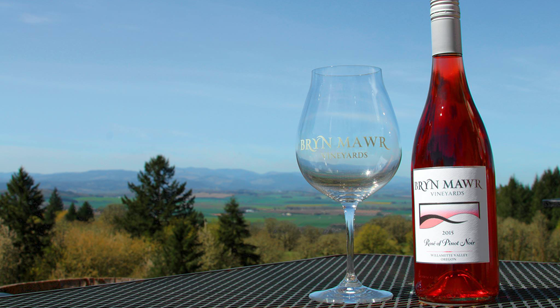Explore Oregon Wines: Wineries | Varietals | AVAs | Cellar 503 Selections

Bryn Mawr Vineyards 2015 Rosé of Pinot Noir
Great wine starts in the field.
It's really easy to make terrible wine. Some grapes, a tank, and some bottles. Presto, you've got bottom-shelf wine.
But really great wine? That requires so many things to go right that you might be forgiven for thinking it's a miracle. For Rachel Rose, winemaker and vineyard manager at Bryn Mawr Vineyards, it all starts with what happens in the fields.
Rachel is one of very few women in Oregon to serve as both head winemaker and vineyard manager. She works with her team at Bryn Mawr to carefully manage each vine, trimming leaf canopy and reducing yields at just the right time.
For Rachel, it's as much science as it is intuition, befitting someone with an undergrad degree in molecular cellular and developmental biology (say that three times fast!) and graduate degrees in oenology and viticulture.
It's also about bringing passion to the work. As Rachel says, "I love to think about wine, drink wine, cook with wine, share wine, and I continually seek to convert the non-believers." After tasting her wine, we're believers!

Cellar 503 Tasting Notes
Bryn Mawr Vineyards, Salem, Oregon
2015 Rosé of Pinot Noir
In the traditional saignée method, rosé was a byproduct of the process of making red wine. In order to intensify a red wine, a winemaker would draw off the lighter juice floating at the top of a tank (increasing the ratio of grape skins to juice) - and then produce the lighter wine as a cheap giveaway for vineyard workers or close friends.
But increasingly in the United States (and almost exclusively among the famed rosé producers of Provence), rosé wines are made intentionally. The grapes are picked early to keep alcohol levels low, the grapes are de-stemmed and crushed, and the juice is kept on the skins for a very short time before pressing. The limited contact ensures that the pigments and tannins from the skins are minimized.
This Bryn Mawr rosé is aged in neutral French oak barrels and kept on its lees (residual yeast) to create depth and complexity. Strawberry pink, it's light and bright on the nose, with notes of raspberry and orange peel. The traditional flavors of Pinot Noir are hinted at in this round, mouth filling wine with a touch of sweetness and finishing with crisp acidity.
A Cellar 503 selection in May 2017, Women Winemakers Yamhill-Carlton | Pinot Noir
